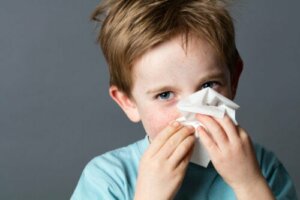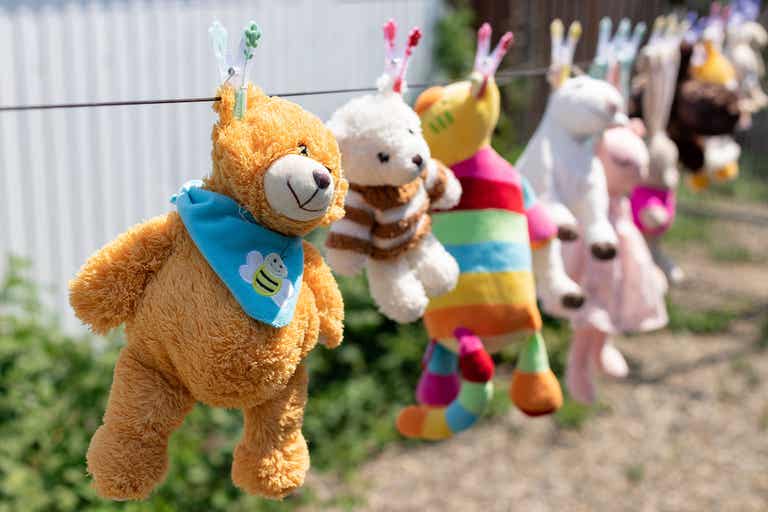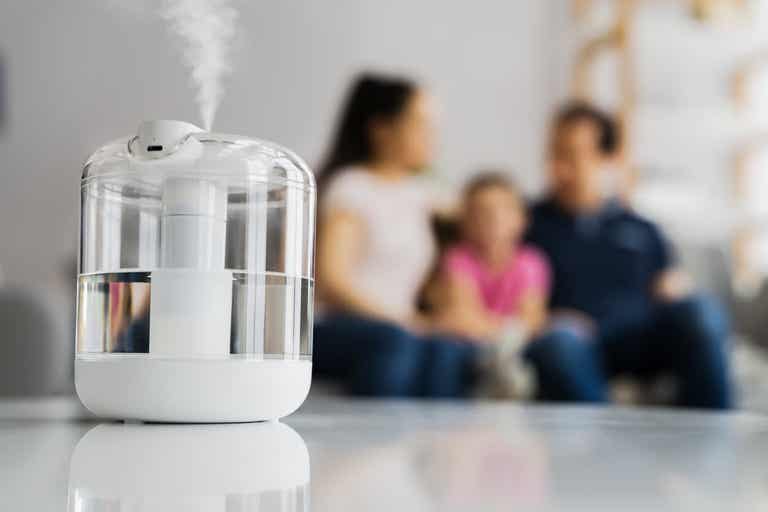10 Tips to Control Dust Allergies in Children

Dust allergies can be a nuisance for children, whether at home, in a store, or in an educational establishment. House dust is difficult to control, so it’s found in almost all environments.
However, in this article, we’ll explain what you can do to control the outbreaks it triggers.
Clinical manifestations of dust allergies
Allergies are an illness in which the person’s immune system interprets an external stimulus as harmful. Therefore, whenever there’s contact with the allergen, some of the following symptoms will manifest themselves:
- Respiratory distress
- Cough
- Nasal mucus
- Asthma attacks
- Hives on the skin
Tips to control your children’s dust allergies
One of the fundamental pillars to control any allergy is to avoid contact with the substance that causes it. In addition, you should implement care and hygiene measures to prevent outbreaks.

1. Avoid dust
Dust, together with pollen, animal hairs, mites, and fungi, are the most frequent allergens. Symptoms are usually stronger in autumn and spring.
It’s best not to frequent places or environments that have a high concentration of house dust and, therefore, a large number of dust mites.
2. Use the vacuum cleaner to prevent dust allergies
It’s essential to maintain hygiene and cleanliness of dust in the home, especially in the bedrooms. In fact, to remove dust from carpets or floors, it’s best to use a vacuum cleaner with an anti-dust mite filter (high-efficiency particulate air filter).
The use of a broom isn’t recommended, as sweeping moves dust from one place to another. You should also clean the furniture with a damp cloth, which doesn’t move the dust but collects it.
You may be interested in: 10 Natural Remedies for Pollen Allergy
3. Protect the mattresses
Mattresses are one of the places where dust and dust mites accumulate and proliferate the most. Therefore, you should cover the mattress and pillows with breathable and anti-mite covers.
Likewise, wool and feather pillows and mattresses are contraindicated in children with a history of allergies. In addition, you should wash sheets at least once a week.
4. Regulate the temperature
Humidity and temperatures between 77ºF and 95ºF are some of the most important environmental factors that influence the presence of dust mites.
Therefore, most homes have an ideal humidity and temperature for dust mites to develop and live.
5. Avoid stuffed animals
Stuffed animals or carpets absorb dust and can act as a trigger for allergic symptoms. If your child has diagnosed dust allergies, avoid placing stuffed animals or cushions in their room.
Even fabric curtains and bookshelves with books and ornaments should be removed.
6. Constant changing of bedding to relieve dust allergies
Washing of bedding, including sheets and quilts, should be done regularly. While it doesn’t need to be daily, they should ideally be washed every week.
A study published in 2021, stresses the importance of using hot water washing cycles in the washing machine.
7. The choice of beds
One of the most important steps for parents is to start decorating their child’s bedroom. In it, the choice of the bed is essential.
If your child has a background of allergies, try to choose beds with metal or wooden frames that aren’t upholstered. At the same time, it’s not a good idea for them to sleep on armchairs or sofa beds.
8. Filter control
Try to replace the filters that are part of the air filters or air conditioners in your home. In general, each manufacturer has its own indications, which average 3 months.
Although flat filters are more economical, pleated filters are more effective in their function.
9. Avoid room humidifiers
As mentioned above, dust mites thrive in humid environments. Consequently, it’s best to avoid the use of humidifiers in bedrooms.
However, in children with a history of atopy, the use of humidifiers is accepted to prevent dry skin.

10. Avoid wearing shoes in the home
Dust can get on children’s shoes when they play outdoors. Therefore, they bring dust into the living space without being aware of it.
A good measure is to avoid wearing shoes inside the home or to designate certain shoes for home use only.
Dust allergies and the sufferer’s quality of life
If house dust allergies aren’t properly controlled or prevented, they can have a negative impact on interpersonal relationships, quality of life, and development.
In this case, when it affects your child’s daily life, it’s best to see a pediatrician to start appropriate treatment.
Dust allergies can be a nuisance for children, whether at home, in a store, or in an educational establishment. House dust is difficult to control, so it’s found in almost all environments.
However, in this article, we’ll explain what you can do to control the outbreaks it triggers.
Clinical manifestations of dust allergies
Allergies are an illness in which the person’s immune system interprets an external stimulus as harmful. Therefore, whenever there’s contact with the allergen, some of the following symptoms will manifest themselves:
- Respiratory distress
- Cough
- Nasal mucus
- Asthma attacks
- Hives on the skin
Tips to control your children’s dust allergies
One of the fundamental pillars to control any allergy is to avoid contact with the substance that causes it. In addition, you should implement care and hygiene measures to prevent outbreaks.

1. Avoid dust
Dust, together with pollen, animal hairs, mites, and fungi, are the most frequent allergens. Symptoms are usually stronger in autumn and spring.
It’s best not to frequent places or environments that have a high concentration of house dust and, therefore, a large number of dust mites.
2. Use the vacuum cleaner to prevent dust allergies
It’s essential to maintain hygiene and cleanliness of dust in the home, especially in the bedrooms. In fact, to remove dust from carpets or floors, it’s best to use a vacuum cleaner with an anti-dust mite filter (high-efficiency particulate air filter).
The use of a broom isn’t recommended, as sweeping moves dust from one place to another. You should also clean the furniture with a damp cloth, which doesn’t move the dust but collects it.
You may be interested in: 10 Natural Remedies for Pollen Allergy
3. Protect the mattresses
Mattresses are one of the places where dust and dust mites accumulate and proliferate the most. Therefore, you should cover the mattress and pillows with breathable and anti-mite covers.
Likewise, wool and feather pillows and mattresses are contraindicated in children with a history of allergies. In addition, you should wash sheets at least once a week.
4. Regulate the temperature
Humidity and temperatures between 77ºF and 95ºF are some of the most important environmental factors that influence the presence of dust mites.
Therefore, most homes have an ideal humidity and temperature for dust mites to develop and live.
5. Avoid stuffed animals
Stuffed animals or carpets absorb dust and can act as a trigger for allergic symptoms. If your child has diagnosed dust allergies, avoid placing stuffed animals or cushions in their room.
Even fabric curtains and bookshelves with books and ornaments should be removed.
6. Constant changing of bedding to relieve dust allergies
Washing of bedding, including sheets and quilts, should be done regularly. While it doesn’t need to be daily, they should ideally be washed every week.
A study published in 2021, stresses the importance of using hot water washing cycles in the washing machine.
7. The choice of beds
One of the most important steps for parents is to start decorating their child’s bedroom. In it, the choice of the bed is essential.
If your child has a background of allergies, try to choose beds with metal or wooden frames that aren’t upholstered. At the same time, it’s not a good idea for them to sleep on armchairs or sofa beds.
8. Filter control
Try to replace the filters that are part of the air filters or air conditioners in your home. In general, each manufacturer has its own indications, which average 3 months.
Although flat filters are more economical, pleated filters are more effective in their function.
9. Avoid room humidifiers
As mentioned above, dust mites thrive in humid environments. Consequently, it’s best to avoid the use of humidifiers in bedrooms.
However, in children with a history of atopy, the use of humidifiers is accepted to prevent dry skin.

10. Avoid wearing shoes in the home
Dust can get on children’s shoes when they play outdoors. Therefore, they bring dust into the living space without being aware of it.
A good measure is to avoid wearing shoes inside the home or to designate certain shoes for home use only.
Dust allergies and the sufferer’s quality of life
If house dust allergies aren’t properly controlled or prevented, they can have a negative impact on interpersonal relationships, quality of life, and development.
In this case, when it affects your child’s daily life, it’s best to see a pediatrician to start appropriate treatment.
All cited sources were thoroughly reviewed by our team to ensure their quality, reliability, currency, and validity. The bibliography of this article was considered reliable and of academic or scientific accuracy.
- Chad, Z. Alergias en niños. Pediatría y salud infantil vol. 6, 8 (2001): 555 – 66. doi: 10.1093 / paquete / 6.8.555
- Aggarwal P, Senthilkumaran S. Alergia a los ácaros del polvo. [Actualizado el 12 de agosto de 2021]. En: StatPearls [Internet]. Treasure Island (FL): StatPearls Publishing; 2021 enero-. Disponible en: https://www.ncbi.nlm.nih.gov/books/NBK560718/
- Zuiani, Chiara y Adnan Custovic. Actualización sobre las medidas de prevención de alérgenos de ácaros del polvo doméstico para el asma. Informes actuales sobre alergia y asma vol. 20,9 50. 19 de junio de 2020, doi: 10.1007 / s11882-020-00948-y
- Halken S. Prevention of allergic disease in childhood: clinical and epidemiological aspects of primary and secondary allergy prevention. Pediatr Allergy Immunol. 2004 Jun;15 Suppl 16:4-5, 9-32. doi: 10.1111/j.1399-3038.2004.0148b.x. PMID: 15125698.
This text is provided for informational purposes only and does not replace consultation with a professional. If in doubt, consult your specialist.








